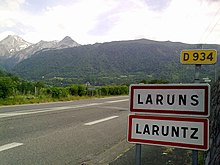Béarnese dialect
| Bearnese | |
|---|---|
| Bearnés | |
| Native to | France |
| Region | Nouvelle-Aquitaine |
Native speakers | ca. 55 000[citation needed] (2001) |
| Official status | |
Recognised minority language in | |
| Language codes | |
| ISO 639-3 | – |
| Glottolog | bear1240 |
| IETF | oc-gascon-u-sd-fr64 |
 Bearnese area. | |
Béarnese (endonym bearnés or biarnés) is the variety of Gascon spoken in Béarn.
The usage of a specific name for Béarnese lies in the history of
The
Béarnese remained the majority language among the Bearnais people in the 18th century. It was not until the second half of the 19th century that its use declined in favor of French. The French school entered into direct conflict with the use of regional languages in the last third of the nineteenth century and until the first half of the twentieth century, causing a clear decline in the transmission of Béarnais within the families from the 1950s. As a reaction, the first calandreta school was created in Pau in 1980, allowing for the revival of its teaching. The number of speakers of Béarnais is difficult to estimate; a 2008 survey suggests that 8 to 15% of the population speaks Béarnese, depending on the definition chosen.

Definition
Name
The word Béarnese comes from the
The use of the name "Béarnese" continued in the following centuries, as with
The expression "Béarnese language" was used as early as Arnaud de Salette in the 16th century, "la lengoa bernesa", and this use is not based on a scientific observation, but on an identity approach, in a context of rising Béarn nationalism. The expression langue béarnaise continues to be regularly used thereafter, a use that is now historical, but still not scientific.
Bearnese whistled language
In the village of Aas, Pyrénées-Atlantiques, shepherds maintained a whistled language until the 20th century. According to Graham Robb, very few outsiders knew of the language until a 1959 TV program mentioned it. Whistles were up to 100 decibels, and were used for communication by shepherds in the mountains and by women working in the fields.[1] During the Nazi occupation of World War II, the language was used to ferry refugees across the France–Spain border.
Today the language can be learnt at the University of Pau and the Adour region.
Geography
Linguistic area
The origin of the notion of the Béarnese language is based solely on political considerations. In the middle of the 16th century,
Sociolinguistics
This section needs to be updated. (April 2022) |
Béarnese is currently the most prominent variety of Gascon. It is widely used in the normativization attempts to reach a standard Gascon and is the most likely dialect to succeed, due to the stronger cultural identity and output of this area.[citation needed] A 1982 survey of the inhabitants of Béarn indicated that 51% of the population can speak Béarnese, 70% understood it, and 85% were in favor of preserving the language.[2] However, use of the language has declined over recent years as Béarnese is rarely transmitted to younger generations within the family. There is a revival of focus on the language which has improved the situation, though, leading children to be taught the language in school (comparable to the way Irish students are taught a standardized form of Irish). Currently, the majority of the cultural associations consider Gascon (including Béarnese) an Occitan dialect. However, other authorities consider them to be distinct languages, including Jean Lafitte, publisher of Ligam-DiGam, a linguistic and lexicography review of Gascon.[3]
A detailed sociolinguistic study presenting the current status of the language (practice and different locutors' perceptions) has been made in 2004 by B. Moreux (see Sources): the majority of native speakers have learned it orally, and tend to be older. On the other hand, the proponents for its maintenance and revival are classified into three groups: Béarnists, Gasconists and Occitanists, terms which summarize the regional focus they give respectively to their language(s) of interest: Béarn, Gascony or Occitania.
Status and recognition

Used from the middle of the
The departmental council of the

Literature
During the 17th century, the Béarnese writer
After the creation of the
Noticeable representatives of modern béarnese literature include poets Roger Lapassade, and novelists Eric Gonzalès, Serge Javaloyès, and Albert Peyroutet.
See also
- Souletin dialect, a neighboring Basque dialect influenced by Béarnese phonology and vocabulary
References
- ISBN 9780393059731.
- ^ The Ethnologue on Gascon (15th edition)
- ^ DiGam project
- ^ "Website about Béarnese folksong with Despourrins's song recorded". Archived from the original on 2012-03-29. Retrieved 2011-09-20.
- Robert Lafont, op. cit (448)
- ^ Argentine edition of Peyret's poetry
Sources
- París: P.U.F., 1970.
- Molyneux R-G (2007). Grammar and Vocabulary of the language of Bearn. For Beginners (reissue ed.). Pyremonde/PrinciNegue. ISBN 978-2-84618-095-5.
- Mooney, Damien (2014). "Béarnais (Gascon)" (PDF). .
- Moreux, B. (2004). Bearnais and Gascon today: language behavior and perception. The International Journal of the Sociology of Language,169:25-62.
